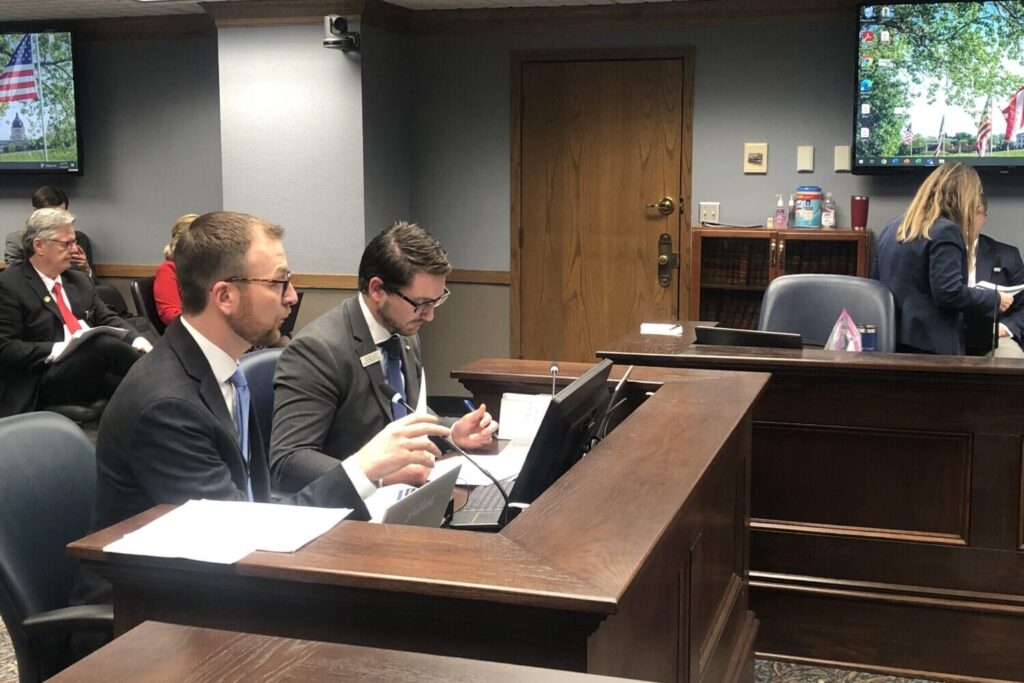
Derek Johnson, state economist with the governor’s Bureau of Finance and Management, and LRC Chief Fiscal Analyst Jeff Mehlhaff (left to right) present to the Revenue Projection Subcommittee in Pierre during the 2023 legislative session. (Makenzie Huber/South Dakota Searchlight)
South Dakota lawmakers should expect an even tighter state budget next legislative session with revenues potentially $24.5 million less than projected, the Legislature’s budget committee learned this week.
Fiscal experts with the Legislative Research Council and the governor’s Bureau of Finance and Management briefed the committee Wednesday in Pierre.
They said the lagging revenue is due partly to recent wage growth in the state failing to significantly outpace inflation, which means South Dakotans are spending less money.
The state relies heavily on sales tax, in addition to lottery taxes, insurance taxes and contractor’s excise taxes. Projections expect revenue will increase compared to the last fiscal year, but not as much as lawmakers planned for.
The two agencies project the state’s general fund this fiscal year, which began July 1, will be short between $18.3 million and $24.5 million compared to estimates that lawmakers adopted during the legislative session that ended in March.
Fiscal responsibility or neglect of state priorities: Surplus sparks debate about budget cuts
Paired with federal funding cuts impacting state programs and nonprofits, state Sen. Ernie Otten, R-Tea, told South Dakota Searchlight “every agency and group will have their hands out this year.” Otten is the lead co-chair of the Appropriations Committee.
“We’re going to have some very hard discussions coming on in just a few months, and we’re going to have to pick winners and losers,” Otten told committee members. “When we do this, we’re going to actually have to pick and know we’re harming people while we’re trying to help people. And this is just going to be the way things have to be.”
South Dakota reported a $63 million surplus for the fiscal year that ended June 30, largely driven by higher-than-expected revenue from unclaimed property. Next year, lawmakers plan to begin transitioning unclaimed property revenue into a trust fund and limiting the amount that can go to the general fund to support the budget.
“We won’t have the unclaimed property money to bail out the general fund next year,” said LRC Chief Fiscal Analyst Jeff Mehlhaff, stressing the need for accurate budget forecasting.
Unclaimed property consists of an array of abandoned or forgotten private assets, including money from bank accounts, PayPal accounts, stocks, life insurance payouts, uncashed checks, unused refunds, and the contents of safe deposit boxes. Holders of the money or items, such as banks, try to find the owners. The property reverts to the state after three years.
SD Public Broadcasting considering cuts, layoffs after Congress rescinds federal funding
State sales tax revenue finished the 2025 fiscal year $3.7 million below projections. Bureau Commissioner Jim Terwilliger said monthly year-to-date sales tax revenue growth in the 2025 fiscal year consistently stayed below the prior year.
“I think the only time that’s happened previously would have been in fiscal year 2010, which would have been right in the middle of the Great Recession, when a lot of states were facing a lot of economic and financial challenges,” Terwilliger said.
Mehlhaff and Bureau of Finance and Management Economist Derek Johnson expect this fiscal year’s sales and use tax to be slightly below the legislative adopted estimate, by about 0.6% to 0.9%, or between $9 million and $13 million short.
The agriculture industry started to show signs of strain last year. Farm machinery sales tax revenue was down 21% in fiscal year 2025, Johnson said.
The biggest indicator of state revenue health to Otten, he said, is the state’s lottery revenue. Revenue in that category ended the last year $5.78 million short of what lawmakers projected. Both the bureau and the council expect another shortfall in projected revenue for fiscal year 2026, around $4 million.
Insurance company tax revenue was one of the few sources to overperform last year, growing 9.9% over fiscal year 2024 numbers. In fiscal year 2026, the bureau projects it’ll outpace expectations again, bringing in $3.5 million more than lawmakers expected.
But more revenue in that one area doesn’t bode well for others, said Rep. Al Novstrup, R-Aberdeen. The source is a tax on insurance premiums, so it’s a sign of rising costs to consumers.
“When that goes up,” Novstrup said, “that’s a really bad thing.”
Let us keep tabs on the Legislature for you. Sign up for our free newsletter.


